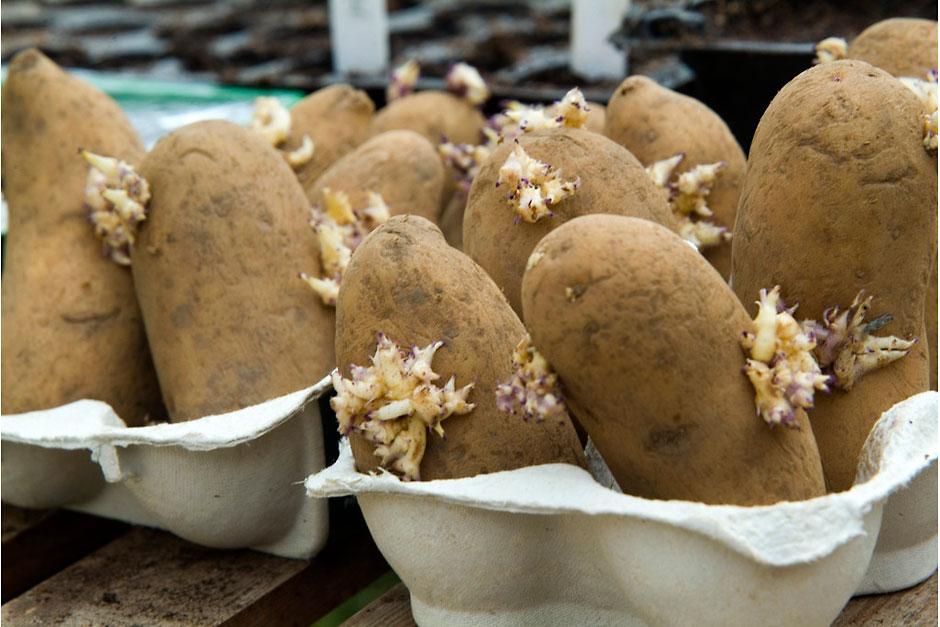? A Family’s Guide to Chitting Potatoes
Hey there, green-thumb families! Are you ready to join the fabulous world of growing your very own potatoes right in your backyard or even on your balcony? Well, you’re in luck, because today we’re digging into the fascinating process of chitting potatoes! Whether you’re a seasoned gardener or just starting out, this guide is tailored just for you and your sprouting little helpers!
? What is Chitting, Anyway?
Chitting potatoes is a fun and simple activity that the whole family can get involved in. Essentially, it’s the process of encouraging your seed potatoes to sprout before you plant them in the ground. This little head start gives you the chance to harvest your potatoes earlier and can lead to a bigger bounty of these tasty tubers.
Why Should You Chit Potatoes?
- Quicker Growth: By chitting your potatoes, you’re giving them a nifty leg-up in their growing journey. You could be enjoying your homegrown potatoes much faster!
- Stronger Sprouts: Chitting gives you the ability to select the strongest sprouts, ensuring a more vigorous plant.
- Family Bonding: Chitting is ideal for getting children involved in gardening. It’s a great sensory experience and tremendously educational.
? When to Start Chitting Potatoes
The ideal time to start is late winter to early spring, around six weeks before you intend to plant them outside. As for the exact month, it depends on your region’s climate, so aim for when there is no more risk of frost and the soil begins to warm up—usually between February and April.
? What You Will Need:
- Seed Potatoes: These are potatoes specifically sold for planting. Make sure to choose certified disease-free spuds for a healthy start.
- Egg Cartons or Trays: Perfect for keeping those seed potatoes upright! If you don’t have any lying around, simple shallow boxes or crates will work too.
- A Cool, Light Spot: Potato chits love cool (but not cold) and bright locations to grow their sprouts—think of a well-lit room or porch that doesn’t dip below freezing.
? A Step-by-Step Guide to Chitting Your Potatoes
Now, let’s roll up our sleeves and get to the root of it! Remember, the magic of gardening is in the details.
Step 1: Sorting Your Potatoes
Begin by inspecting your seed potatoes and choosing the best ones. You’re looking for firm potatoes with no signs of rot or damage. Get the kids to help by handing them potatoes and making it a sort of ‘treasure hunt’ game for healthy spuds.
Step 2: Arrange in Egg Cartons or Trays
Place each seed potato with the most ‘eyes’ (little indentations from where sprouts will grow) facing upward in an egg carton or on a tray. This is a perfect counting exercise for younger children, and a great practical lesson on plant biology for the older ones.
Step 3: Find the Perfect Spot
Position your potato-filled cartons or trays in a cool, light-filled location. You want to avoid direct sunlight—a bright room that doesn’t get too warm is ideal. This is a great time to explain the importance of sunlight for plant growth and to discuss the process of photosynthesis, even with little ones!
Remember to check on your potatoes regularly and watch for the sprouts to develop! It’s a little like watching the plants wake up from their winter slumber. The anticipation can be just as thrilling for your kids as it is for you. As the days go by, you’ll all have the joy of watching your spuds’ eyes transform into strong, green shoots, ready to be planted in your garden.
Getting your potatoes chitted is the first step to a fruitful harvest that you and your family can enjoy together. In our next section, we’ll look at what to do once those chits are ready and cover some troubleshooting tips to ensure your potato planting goes off without a hitch, so stay tuned! And don’t forget, gardening isn’t just about the end produce—it’s about the memories and knowledge you gain along the journey. Get ready to learn, laugh, and grow together!

? 5 Things Parents Should Know Before Chitting Potatoes
1. Patience is Key
Anticipate that chitting potatoes is not an overnight process. It takes about 2-3 weeks for sprouts to grow adequately before they can be planted. This waiting period can be a great lesson for children on patience and the gradual nature of growth.
2. Quality Matters
Not all potatoes are equal when it comes to chitting. You should use high-quality, certified seed potatoes to avoid disease and achieve the best results. This ensures that your effort in chitting and planting yields a healthy, abundant crop.
3. Sunlight and Temperature
Choose a spot in the home that offers indirect sunlight and keeps a stable, cool temperature. Avoid places that are too warm, as this can lead to weak, leggy sprouts. Inform your children that plants need the right conditions to grow strong, just like they need a balanced diet and proper exercise to grow healthy.
4. Learning Opportunity
Use this as an educational opportunity. Gardening can teach children valuable lessons about nature, science, and even responsibility as they take part in nurturing the seed potatoes. It can spark curiosity about where their food comes from and the importance of sustainable practices.
5. Handling Disappointments
Despite our best efforts, some chits may not sprout, or some potatoes could turn out to be duds. This is a natural part of gardening and a chance to teach children to handle disappointments and understand the unpredictable elements of nature.
? Chitting Journey: Observing and Learning
While chitting your potatoes, take note of the gradual changes and document them if possible. Children love to see the progression and this can serve as a visual representation of their efforts and dedication. You can even mark important milestones on a calendar to involve them in tracking the chitting process.
Step 4: Sprout Watching and Rotation
Monitor the growth of the sprouts. If you notice some potatoes are sprouting faster than others, rotate the position of the potatoes in the trays or egg cartons. This ensures even light exposure and can stimulate even growth among all your seed potatoes.
Step 5: Preparing for Planting
Once the sprouts are about 1-2 cm long, and with a good few weeks before the last frost, start preparing your garden plot. Involve your family in clearing the area, adding compost, and learning about soil health. You want rich, well-drained soil for the potatoes to flourish.
Tip: Try cutting larger seed potatoes into pieces a few days before planting. Each piece should have at least one or two sprouts. Let the cut surface callus over to prevent rotting. This can be a great discussion point about plant regeneration and healing.
? Watering and Care Post-Chitting
Teach your kids the importance of regular, but not excessive, watering once the potatoes are planted. Overwatering can lead to rot, while underwatering can stress the plant. A balanced approach is best, and setting a watering schedule can be a fun and responsible task for children.
Your family’s journey with chitting potatoes is sure to be filled with learning and joy. Remember, it’s not just the beautiful potatoes you harvest but the smiles, the teamwork, and the little hands covered in soil that truly make this a memorable experience. Happy chitting!
See more great Things to Do with Kids in New Zealand here. For more information see here
Disclaimer
The articles available via our website provide general information only and we strongly urge readers to exercise caution and conduct their own thorough research and fact-checking. The information presented should not be taken as absolute truth, and, to the maximum extent permitted by law, we will not be held liable for any inaccuracies or errors in the content. It is essential for individuals to independently verify and validate the information before making any decisions or taking any actions based on the articles.




